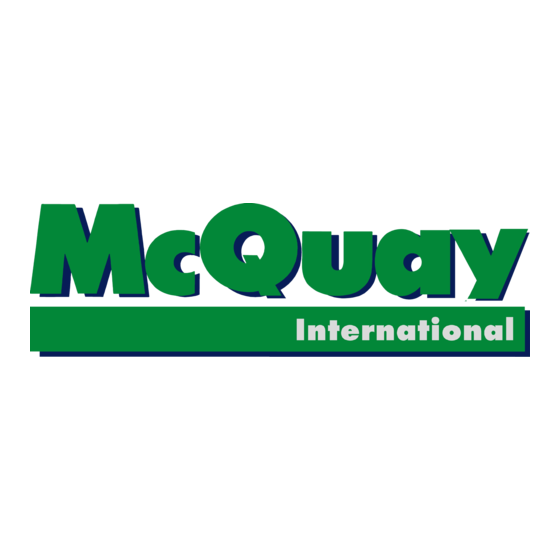
Summarization of Contents
Introduction
General Description
Describes the McQuay PEH/PHH centrifugal water chillers as self-contained units.
Operation
Operator Responsibilities
Outlines the operator's duties for safe and efficient chiller operation and maintenance logging.
Nomenclature
Explains the identification system for chiller units and components.
Operating Sequence
Describes the step-by-step process of starting, operating, and shutting down the chiller.
Control System
Overview of the control center, components, and their functions in chiller operation.
Maintenance
Routine Maintenance
Covers essential periodic checks and tasks for daily operation.
Lubrication
Instructions for adding oil, changing filters, and general lubrication procedures.
Refrigerant Cycle
Monitoring operating conditions, superheat, and refrigerant charge.
Electrical System
Checking current draw, oil heaters, safety controls, and motor resistance.
Cleaning and Preserving
Importance of cleanliness for filters, strainers, and cooling tower components.
Seasonal Servicing
Procedures for preparing the chiller for shutdown or startup based on seasonal changes.
Annual Shutdown
Steps to prevent freezing damage, secure the unit, and protect components.
Annual Startup
Procedures for preparing the chiller for operation after seasonal shutdown, including checks.
Repair of System
Pumping Down
Method for reducing system pressure safely while maintaining water flow.
Pressure Testing
Procedure for testing system integrity after repairs or refrigerant loss.
Leak Testing
Steps to identify refrigerant leaks using nitrogen and leak detection methods.
Evacuation
Process for removing air and moisture from the system using a vacuum pump.
Refrigerant Charging
Triple Evacuation Method
Recommended procedure for achieving deep vacuum and removing non-condensables.
Refrigerant Charging
Guidelines for adding refrigerant, checking nameplate, and achieving proper superheat/subcooling.
Adjustments
Current Limit Calibration
Steps to set the maximum compressor motor current limit using the control module.
Temperature Calibration
Procedure for field calibrating the control module's temperature setpoint and pointer alignment.
Ramp-Up Calibration
Adjusting startup ramp-up time and start point for controlled compressor loading.
Pulse Rate Calibration
Setting the vane repositioning speed to match system requirements for stable control.
Current Transformer Signal
Information on factory calibration of the CT signal for motor current monitoring.
Vane Speed Adjustment
Adjusting needle valves to control the opening and closing speed of compressor inlet vanes.
Load Recycling Thermostat Setting
Procedure for setting the LRT to control compressor cycling based on leaving chilled water temperature.
Low Oil Temperature Thermostat
Setting the LOT to prevent compressor start-up with cold oil and ensure bearing protection.
Troubleshooting Guide
Control Panel Lights Troubleshooting
Diagnosing faults based on illuminated indicator lights on the control panel.
Motor Temperature Faults
Troubleshooting steps for issues related to motor temperature and protection systems.
Oil Pressure Faults
Identifying and resolving problems associated with oil pressure and pump operation.
Oil Temperature Faults
Diagnosing issues related to oil cooler operation and oil temperature sensing.
Low Pressure Faults
Troubleshooting low pressure conditions, refrigerant flow restrictions, and expansion valve issues.
Discharge Temperature Faults
Resolving issues causing high discharge temperature, low refrigerant flow, or high superheat.
Discharge Pressure Faults
Diagnosing problems related to cooling tower issues, refrigerant overcharge, or system air.
External Failure
Troubleshooting external power interruptions, water flow issues, or control circuit faults.
Compressor Not Running
Steps to identify why the compressor starter is energized but the compressor does not start.
Load Recycle
Troubleshooting issues related to thermostat settings, load changes, and water temperatures.
Surgegard
Diagnosing surge conditions, high pressure lift, and cooling tower performance issues.
Compressor Starter Overload Tripped
Resolving issues causing compressor starter overloads, including calibration and CT problems.
Hunting
Diagnosing and fixing causes of compressor hunting, such as vane speed or refrigerant charge.
Compressor Will Not Load
Steps to troubleshoot why the compressor fails to load, including control module and solenoid issues.
Compressor Will Not Unload
Identifying reasons why the compressor fails to unload, such as solenoid or valve issues.
Cannot Reset Control Circuit
Troubleshooting issues preventing the control circuit from being reset after a fault condition.
Log Sheet
Full Load Design Conditions
Section for recording design parameters for chiller and condenser systems.
Water System Weekly/Quarterly Logging
Log entries for water system parameters recorded weekly and quarterly.
McQuay Service Programs
Comprehensive Maintenance Plan
Details on McQuay's service plan covering inspections, parts, labor, and refrigerant.












Need help?
Do you have a question about the PEH100 and is the answer not in the manual?
Questions and answers